Van Leeuwen and the art of not advertising.How to scale your brand without ads
“We don’t advertise” is a common refrain I see in founder stories. It’s usually a way to communicate product quality. Our product is so good we didn’t have to advertise.
Ads are expensive. So not advertising is an attractive business strategy. But just because you don’t advertise, doesn’t mean you don’t market. Every company needs some sort of customer acquisition strategy. It just doesn’t need to be advertising.
In this case, the non-advertising brand is Van Leeuwen, an artisanal ice cream brand that started with a single cart in 2008 and now boasts 50 locations across the US, plus retail distribution in stores from WalMart to Whole Foods. Co-founder Ben Van Leeuwen started the brand as a way to offer ice cream made up of only simple, high quality ingredients. Fun fact: Van Leeuwen based his original formulation on an ice cream recipe from French chef Thomas Keller of Michelin starred Per Se and French Laundry.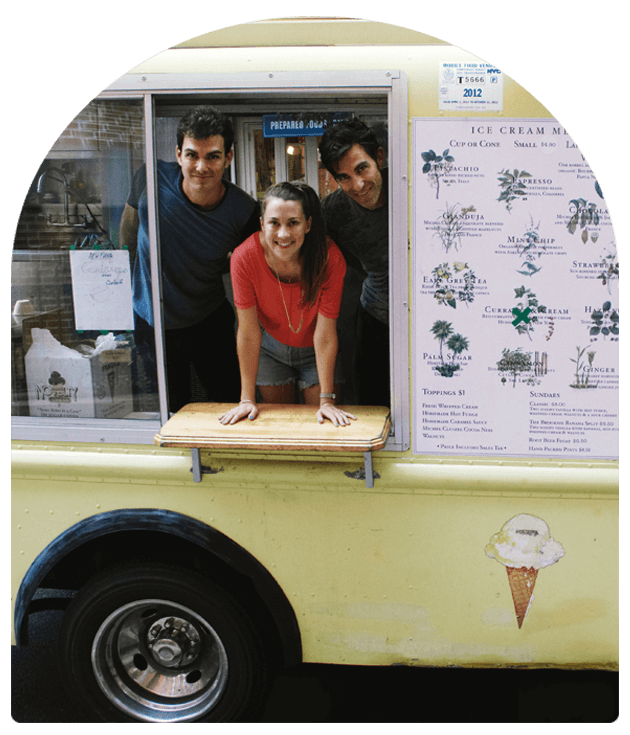 Founders Ben, Pete, and Laura in their original ice cream truck. Source: Van Leeuwen
Founders Ben, Pete, and Laura in their original ice cream truck. Source: Van Leeuwen
A CNBC profile on Ben noted that the brand has grown without spending any money on advertising.
I checked on Facebook Ad library to confirm — I couldn’t help myself— and all that came up is a lonely ad that ran for 3 days in December 2019. Okay, so maybe Van Leeuwen really doesn’t advertise.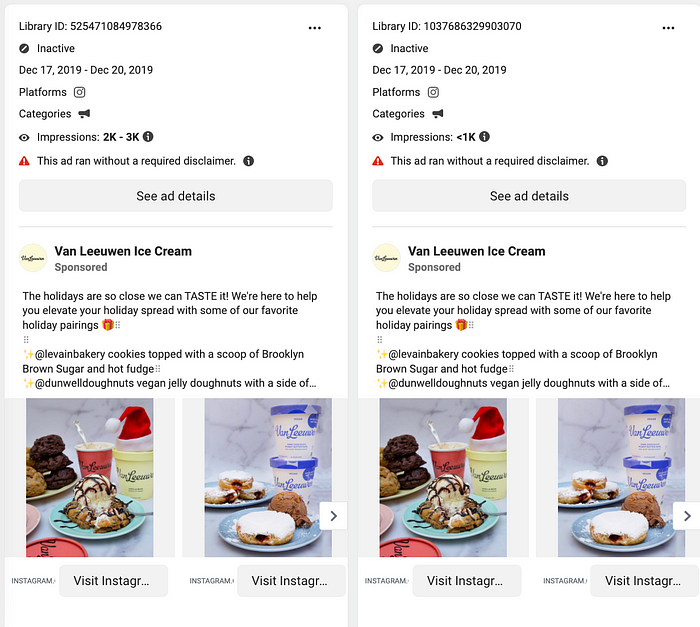 Van Leeuwen’s sole Facebook ad. Source: Meta
Van Leeuwen’s sole Facebook ad. Source: Meta
Does that mean Van Leeuwen’s marketing expenses are zero?No. They are still marketing. Quite successfully, too.
How did Van Leeuwen’s founders scale the brand with no ads?1. Invest in FMOT with stellar packaging
Van Leeuwen sells a majority of its ice cream via retailers like Wal-Mart and Whole Foods. Success in these stores depends on winning at the shelf — the moment when a customer is standing in the store aisle deciding which ice cream to buy. At P&G, engineering the shelf purchase decision is so important that it has its own internal acronym, FMOT, which stands for ‘First moment of truth.’
Van Leeuwen’s team needed to convey what makes them different in the time it takes a shopper to glance down the aisle. To do this, the team hired famed design agency Pentagram in 2017.
Pentagram translated Van Leeuwen’s simple ingredients into a design language that removes almost everything from the packaging, leaving only pastel colors and lots of negative space to convey pure, ‘good-only’ ingredients.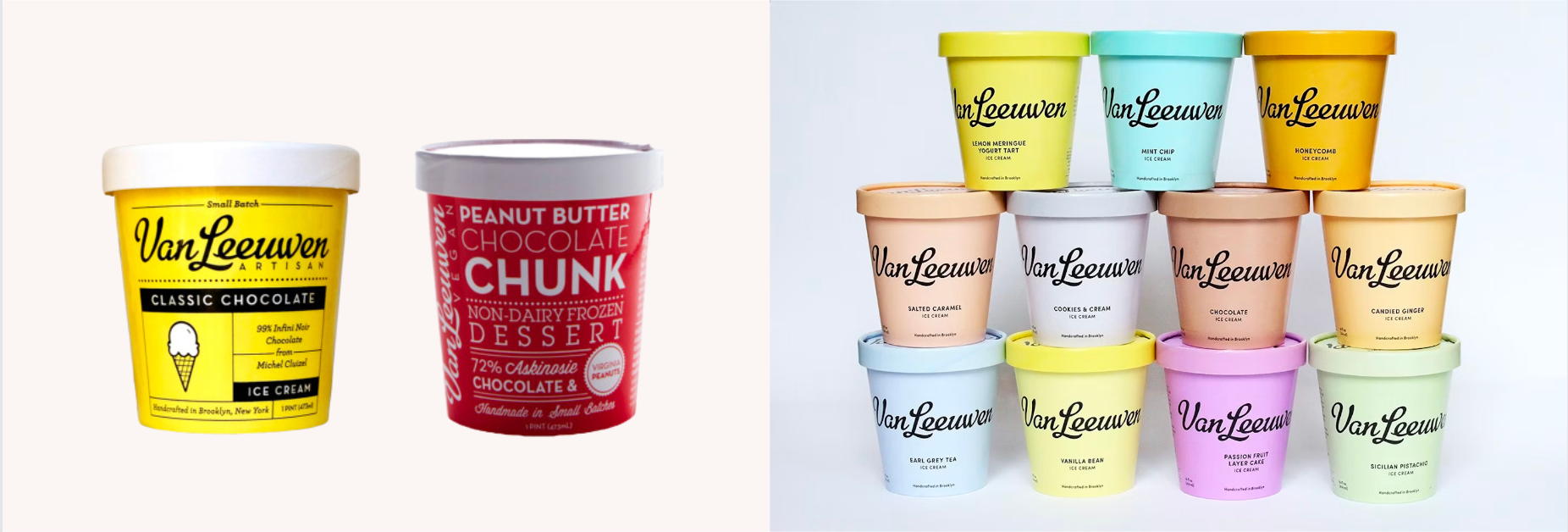 Van Leeuwen packaging before and after. Source: Pentagram.
Van Leeuwen packaging before and after. Source: Pentagram.
On shelves full of pints with old-fashioned typography, cutesy illustrations and general visual clutter, Van Leeuwen’s cheery pastels and clean type are eye-catching in their simplicity. — Fast Company
While the simplified packaging looks good on its own, it looks even better on shelf. The saturated colors and negative space create an almost serene landscape in an otherwise crowded maze of text and pictures and obscure ingredient lists. You cannot not notice Van Leeuwen.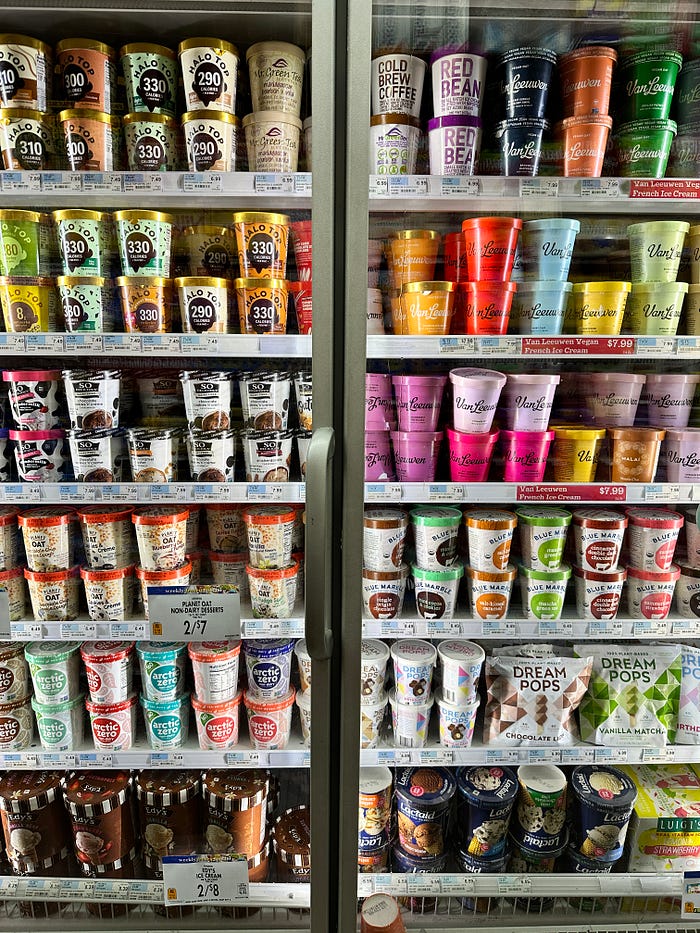 Van Leeuwen’s packaging stands out on shelves at Brooklyn Fare. Source: Author
Van Leeuwen’s packaging stands out on shelves at Brooklyn Fare. Source: Author
The redesign was as good as any ad (if not better), driving a +50% increase in retail sales for Van Leeuwen.
How can other brands emulate Van Leeuwen’s packaging success?
Start with a clear understanding of who you are, and make a list of the attributes you want to convey about your product. Then — go to the store. Make a second list of what you see and feel on the shelf. What are the category norms? What is everyone else saying via colors, text, shape, materials? What can you do that conveys the attributes of list 1, and doesn’t involve the typical category tactics in list 2?
Seeing what’s “not’’ there is hard — but an investment in standout packaging is as good as any ad campaign. In fact, it’s the only ad seen by 100% of your customers.
(A quick aside: If you’re enjoying this article, consider subscribing to my free weekly newsletter, Branding in 4-D, by clicking here!)
2) Earn media via collaborations
Maybe the hottest marketing tactic these days is the brand collaboration, particularly in the food and fashion spaces.A Crocs x Hidden Valley Ranch collaboration. Source: Crocs
Brand collaborations provide an easy route to press and a quick shot of demand via unexpected tie-ups and limited edition products. They can also be used to shift brand associations. For example, Target’s collaborations with Lily Pulitzer and Missoni helped Target shift associations of their clothing upmarket.
Van Leeuwen centers their collaboration strategy around their artisanal ingredients. This month, Van Leeuwen partnered with Chef Jean-Georges on a new Cherry Creamsicle ice cream, debuting at the same time as Jean George’s 50th year of cooking, and Van Leeuwen’s 50th location opening in Times Square.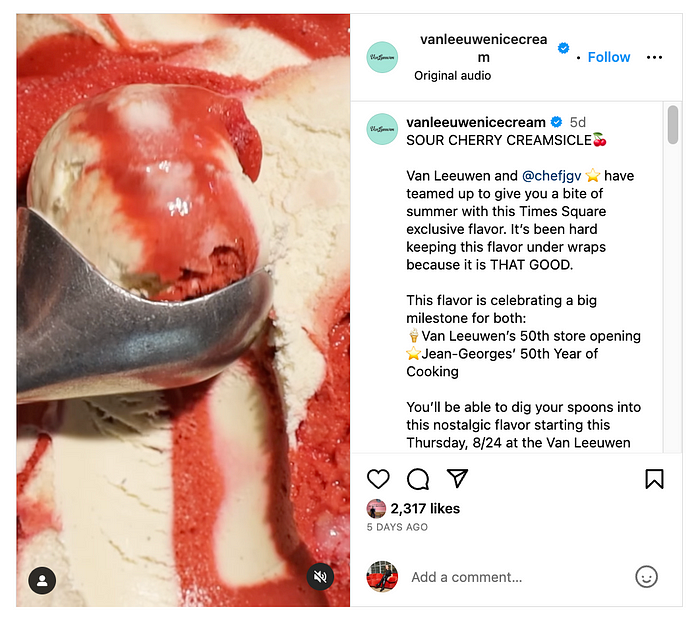 Van Leeuwen x Jean-Georges Collab. Source: Instagram
Van Leeuwen x Jean-Georges Collab. Source: Instagram
Van Leeuwen doesn’t limit their collaborations to high-end culinary partners. The brand partnered with Kraft macaroni and cheese for a 2021 limited edition flavor that sold out in less than an hour.Van Leeuwen x Kraft Collab. Source: Van Leeuwen
And this summer, Van Leeuwen teamed up with Uber to offer a BBQ Gold Cornbread Crumble, available to Uber One customers only.
Collabs generate earned media for [Van Leeuwen], which doesn’t have a budget for paid advertising.
-Morning Brew
How can other brands emulate Val Leeuwen’s success in brand collaborations?
Like the ad market, the collaboration market is quickly saturating. The Atlantic even covered the uptick in brand collaborations in a piece asking for brands to stop engaging in meaningless collabs.Source: The Atlantic
As collabs become more popular, it gets harder to stand out (and get press). Therefore, if you’re toying with collaboration ideas, make sure your idea offers something of value for your audience. For Van Leeuwen’s customers, that value comes in the form of a unique taste experience.
Short-term flavor collaborations, according to Van Leeuwen, should be both iconic and shocking: “When I first heard about Hidden Valley, I was like, ‘Oh my God, that’s crazy. We’re not doing that,’” he said. “Then two minutes later, I was like, ‘Wait, my reaction is exactly why we should do this.’” —Ben Van Leeuwen, Morning Brew
Another tip: make your brand worthy of a collaboration. The brands who do collabs best (and who get to partner with other strong brands) have a clear point of view, design aesthetic, and/or audience that another brand wants to trade off of.
Crocs are a popular collaborator because their distinctive design is a good canvas for other brands to layer onto. Similarly, Van Leeuwen’s insistence on simple, high-quality ingredients provides an attractive platform for both chefs and traditional food manufacturers who want to associate with good quality ingredients. If your brand does not have a differentiating point of view versus your competitors, it won’t be clear what another brand would get out of a collaboration.
3. Invest in PR, promotions, and events
Every time Van Leeuwen enters a new market with a physical ice cream shop, they need to build awareness among a new set of customers. The Van Leeuwen team leans on local press, pop-up events, and influencers to build buzz and awareness before they open in a new location.
For example — when Van Leeuwen entered the Houston market, they worked with PR agency Integrate to get the launch mentioned in local press and host community events. They also aligned their collaboration calendar with their Houston market entry, partnering with local Chef Hugo Ortega on a Horchata Dulce de Leche Swirl flavor. The flavor was available at the new Van Leeuwen shop as well as one of Ortega’s restaurants, which served as another local media channel for Van Leeuwen. Launch deals such as $1 scoops and prizes built demand and trial.
How can other brands emulate Van Leeuwen’s success in PR?
Media and PR agencies will look for a hook or story before covering your brand. Van Leeuwen is smart to align their collaborations with their local launches, which gives them a strong pitch for new markets. If you want to lean into PR, be honest about why a journalist would want to cover your brand. Once you have an angle, you can design a larger program around it across influencers, events, and promotions.
And they say Van Leeuwen doesn’t advertise…
Investments in PR, high-end brand agencies, and brand collaborations aren’t cheap. But these investments show that Van Leeuwen has a strong understanding of who their customer is, what they want in ice cream, and just when and where they make their buying decisions. Van Leeuwen then designs touchpoints with this information in mind.
They may not be ‘advertising.’ But they are engaging in savvy marketing.
Don’t miss out on brand insights — Sign up for monthly emails.
Looking for help growing your brand?
I run brand consultancy Embedded — where I partner with founders and C-suite executives to unlock brand growth.
Not sure where to start? Many clients opt for ad-hoc coaching — hourly consultations on any aspect of your marketing and brand strategy. Get in touch here, or book a 15 minute free consultation.
















































